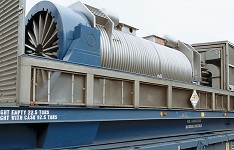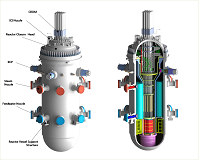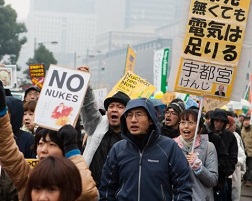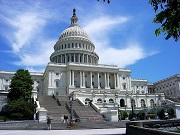Persistent Prejudice Against Nuclear – Can Anything Be Done? Part 2
In last month's post, I made the case that there is substantial prejudice against nuclear power among much of the public in most of the world. As a result, nuclear is held to requirements thousands of times as strict as other energy sources and industries, resulting in nuclear being rendered less competitive economically. This in turn results in the use of fossil generation instead of nuclear, despite the fact that the operational record, the data, and all scientific analyses show fossil-fueled generation to be orders of magnitude more dangerous and harmful.
But alas, this doesn't seem to matter to the public, or policy-makers, or regulatory agencies. Their apparent view is that even small, or very rare, amounts of nuclear-related pollution are completely unacceptable, whereas continual pollution from other sources (most notably fossil fuels) is not a serious concern. They continue to just ignore what the numbers, and experts, are telling them, concerning relative risks/impacts.
The question is: What can possibly be done to change this unacceptable (in my view) situation? As it seems I cannot fit all my thoughts on this matter into a single article of reasonable length, I will begin this month by discussing a few ideas that are held by many in this industry as to what should be done. Next month, I will explore another idea that I have, which (it seems) hasn't been considered.
Improved technology
Most of us who work in the nuclear industry are scientists and engineers, so there is a tendency for us to think the answer to the industry's problems (reactor safety, waste, etc.) is the development of better technology (e.g., advanced reactors and fuel cycles). There is a tendency to believe that inadequate technology is the source of the problem, and that once better technology is developed, the problems will go away. The public will accept nuclear with open arms, it will be competitive economically, and it will capture increasing market share.
My belief is that this view is largely naive. As I said in last month's post, it is an attempt to apply a technological solution to what is not a technological problem. It is mostly a political, regulatory, and public prejudice problem, as opposed to any lack of objective, technological merit of nuclear power.
Waste
The waste "issue" provides a clear example. Even a hypothetical, perfect, closed fuel cycle still involves at least one repository (for fission products) and a waste longevity of ~500-1000 years. Any real, practically achievable fuel cycle will fall short of that. Waste will still have to be shipped to the repository, and so the transport "issue" will not go away.
 It is, frankly, naive to think that having a somewhat shorter (but still unfathomably long for the public) waste life will reduce public/political opposition to a repository one iota. It shows a complete misunderstanding of the source of opposition. Opposition is NOT about genuine concern for the well being of people living in what is currently Nevada from 10,000 to 100,000 years from now. It is about feeling singled out as the nation's sole "waste dump" and the sense that a repository is being imposed, rather than being voluntarily agreed to. That, along with fears of transport accidents and various scares that may drive away tourism or reduce property values. None of these issues will be solved or even ameliorated by advanced/closed fuel cycles.
It is, frankly, naive to think that having a somewhat shorter (but still unfathomably long for the public) waste life will reduce public/political opposition to a repository one iota. It shows a complete misunderstanding of the source of opposition. Opposition is NOT about genuine concern for the well being of people living in what is currently Nevada from 10,000 to 100,000 years from now. It is about feeling singled out as the nation's sole "waste dump" and the sense that a repository is being imposed, rather than being voluntarily agreed to. That, along with fears of transport accidents and various scares that may drive away tourism or reduce property values. None of these issues will be solved or even ameliorated by advanced/closed fuel cycles.
The real truth is that nuclear's (tiny, contained, and well managed) waste stream has always been and always will be an orders of magnitude smaller risk (short term and long term) than the wastes and toxins of other industries. The real problem has always been the public not understanding that, as opposed to any lack of technology. No technology will solve that (real) problem.
It's not as though the news is all bad on the waste front, however. It appears that local communities in both New Mexico and Texas have voluntarily expressed support for the idea of hosting a high level waste repository. Not only that, but their state governments (usually the real source of political resistance) have expressed a willingness to at least consider the idea. Both provide an example of the change in the public acceptance and political equation that occurs when the initiative is voluntary.
Reactors
With respect to reactor accident risk, many advanced reactors and small modular reactors claim core damage or accident frequencies that are orders of magnitude lower than those of today's reactors. But again, do you really think that talking to the public about probabilistic risk assessment analyses and 10-8 vs. 10-4 core damage frequencies will have any significant effect on public opposition? If they were numerate, and based their views on scientific, numerical analyses, they wouldn't be opposed to nuclear (including today's reactors) in the first place. For them, an accident is either "possible" or it's not.
 It could be plausibly argued that essentially precluding even one significant accident or release, any time this century, would reduce the risk of negative political reaction that could significantly set back the industry (like what's happening in Japan). But I would argue that the probability is already quite low, especially given post-Fukushima improvements and lessons learned (along with the lack of tsunami and 9.0 earthquake potential in the United States).
It could be plausibly argued that essentially precluding even one significant accident or release, any time this century, would reduce the risk of negative political reaction that could significantly set back the industry (like what's happening in Japan). But I would argue that the probability is already quite low, especially given post-Fukushima improvements and lessons learned (along with the lack of tsunami and 9.0 earthquake potential in the United States).
In any event, the biggest issue for new reactors is not lack of public acceptance, but cost. This is especially true in the Southeast, where most new reactors would be built anyway. If nuclear isn't cost effective, the possibility of the industry's political rejection some decades from now due to a severe accident is moot, since the industry will have died off anyway. Some feel that advanced reactors will be far less expensive, but this is debatable and remains to be seen.
Many concepts, such as SMRs, give up size and power density in exchange for inherent safety advantages, resulting in the far lower accident probabilities discussed above. The lower power density and smaller size will tend to make SMRs more, not less, expensive. The hope is for volume production to reduce cost. However, what's really needed is to use the SMR's, or advanced reactor's, fundamental advantages to reduce cost, as opposed to further reducing (already extremely low) accident risk. What needs to be discussed is what other (Nuclear Regulatory Commission/quality assurance) requirements can be relaxed so that accident risk is a little better than current plants, but costs are significantly reduced. However, any such discussion would be blasphemous, for both the public and the NRC. Never mind the fact that requiring reactor accident risk to be as low as possible simply means that fossil fuels will be used instead, resulting in a large increase in public health risk.
Also unclear is the real benefit of having a reactor with a smaller potential source term, such as an SMR. The current public and regulatory mindset strongly suggests that smaller releases will simply result in stricter dose criteria being applied, with little reduction in cleanup cost or response in general. It will be 100 mrem/year, or even 10 mrem/yr, vs. 1,000 or 2,000. The dynamic is that the industry will have to "give until it hurts." "How much does it cost? How much you got?!" If you doubt this, note that many states have applied a criterion of 10 mrem/year to an ultra-hypothetical, most-exposed individual, for plant decommissioning projects. (The cost-per-life-saved on that criterion is incalculable....)
The real question is whether any technology can compete if there is such prejudice against it and if it is held to standards thousands of times as strict as competing sources. One approach is to develop some miracle technology that can compete even under a spectacularly unfair playing field. Another is to try and make the playing field more fair. Suffice it to say that I have strong views on which path is more likely to be successful.
Repudiating LNT
Many in our industry believe that the answer lies in winning the scientific debate on the health effects of low-level radiation. The goal would be to obtain a formal rejection of the Linear No Threshold Theory (LNT) by the world scientific community. In its place, a dose rate threshold would be established, below which it would be recognized that there are no health impacts.
 What this threshold would be is open for debate. One idea would be ~1 Rem/year, as that is roughly the top end of fairly common natural background levels, since no evidence of correlation between natural background level and disease rates have been found. Another often mentioned number is 10 Rem/year, the lowest dose rate for which clear statistical evidence of health impacts has been found. Some advocate even higher threshold values.
What this threshold would be is open for debate. One idea would be ~1 Rem/year, as that is roughly the top end of fairly common natural background levels, since no evidence of correlation between natural background level and disease rates have been found. Another often mentioned number is 10 Rem/year, the lowest dose rate for which clear statistical evidence of health impacts has been found. Some advocate even higher threshold values.
At that point, ostensibly, government policies would be changed in response to the new scientific consensus. That would include post-accident (release) evacuation policies, cleanup standards, and standards for radiation levels in food and water. Performance requirements for repositories would also be (dramatically) changed.
While all of this will definitely help, I have doubts as to whether it will be sufficient to achieve the needed changes. The problem with this idea, again, is that it assumes that public opposition, or even regulatory policy, is objective and rational in nature, and not subject to political influence and prejudices. As I've shown through numerous examples, the public, politicians, and even regulatory agencies are already ignoring science, and what the scientific community says.
 Even assuming the LNT, nuclear's public health risks and environmental impacts are orders of magnitude lower than those from fossil fuels. Even assuming the LNT, the total eventual impact of Fukushima (the only significant release of pollution in non-Soviet nuclear's entire history) is less than that inflicted every day by fossil fuels. And yet, after Japan considered setting a reasonable (~1�'2 Rem/year or higher) threshold, below which dose reduction (cleanup) efforts would stop, they retreated and agreed to apply a 100 mrem/year threshold (i.e., a fraction of natural background) due to "public outcry".
Even assuming the LNT, nuclear's public health risks and environmental impacts are orders of magnitude lower than those from fossil fuels. Even assuming the LNT, the total eventual impact of Fukushima (the only significant release of pollution in non-Soviet nuclear's entire history) is less than that inflicted every day by fossil fuels. And yet, after Japan considered setting a reasonable (~1�'2 Rem/year or higher) threshold, below which dose reduction (cleanup) efforts would stop, they retreated and agreed to apply a 100 mrem/year threshold (i.e., a fraction of natural background) due to "public outcry".
Here in the United States, where coal plant pollution continues to kill ~13,000 Americans every single year, and we have events like massive spills of toxic coal ash piles and other toxic chemicals directly into rivers and water supplies, the Environmental Protection Agency is considering regulating nuclear plant tritium releases, despite the fact that these have never had any health impact, with little potential to do so, even assuming LNT.
Also, as I discussed in this post, even the "improved" EPA Public Action Guideline applies a 10�'4 to 10-6 lifetime cancer risk criterion, but only for Superfund sites and nuclear accident scenarios, in a country in which ~25 percent of the population dies of cancer, while continual deaths of tens of thousands per year from fossil fuel pollution (overall) is tolerated. It is clear that political power and influence, as opposed to objective science, is influencing, if not governing, these decisions.
If one assumes a linear relationship between dose and cancer risk, it follows that total health impacts (cancers, deaths) scale directly with collective exposure, i.e., the integral of dose times the number of people exposed (in units of man-Rem). If government policy is ostensibly based on LNT today, you would think that said policy would treat all man-Rems the same. In a clear sign that policies and standards are not objective or science based, that is not true, by many orders of magnitude.
The fact of the matter is that, while LNT, along with a 10�'4 to 10-6 lifetime cancer risk criterion, will be applied to cleanup standards after any nuclear plant release, vastly larger sources of public collective exposure are simply ignored. These include all exposures from natural background (e.g., radon), air travel, and medical exposures to some extent. Exposures to naturally occurring radioactive materials from all other industries (such as coal plant emissions or old oil pipes off the California coast) are also generally ignored.
Radon is estimated to expose on the order of 100 million Americans to hundreds of millirem annually, resulting in an annual collective exposure on the order of 25 million man-Rem. According to the LNT, this results in on the order of ~10,000 annual deaths. Medical exposures are also a huge source of collective exposure (with CAT scans alone causing ~29,000 annual deaths, according to LNT), and the medical community is only starting to pay attention to the issue, with patients and many practitioners hardly thinking about it at all. Both of these sources of collective exposure are orders of magnitude larger than the collective exposure that would result from a worst-case nuclear accident, even if no cleanup efforts were made.
And yet, nothing is being done about them. Little to no money is being spent. People aren't even being warned (not saying they should be). In all those areas (radon, medical), collective exposures could be reduced at a cost (in dollars per man-Rem avoided) that is many orders of magnitude lower than the amount we're planning on spending cleaning up affected areas after a nuclear plant accident. If we really believed in the LNT, and really (and objectively) cared about reducing collective exposure, we would focus on those areas instead.
The LNT is not the problem. Its selective application is the problem. However, one might argue that, even though the LNT is now arbitrarily only being applied to the nuclear industry, if we get the scientific community to agree to a threshold, regulatory agencies would lose their justification for doing so. They would be compelled to respond by dramatically increasing allowable doses. Personally, I have my doubts, given the influence of politics and (prejudiced) public opinion on such decisions. Regulatory agencies respond to public opinion and political pressure, perhaps even more than they respond to scientific consensus or fact, as the examples I give above show.
Again, the biggest problem the nuclear industry faces is the high capital cost of new reactors, as well as high operating costs of existing reactors, due to extreme regulations. Does anyone really think that if the scientific community agrees to a threshold, the NRC will voluntarily drop most nuclear plant safety regulations, under the theory that having meltdowns is now okay? Those regulations, not accident liability, are the main source of high nuclear costs. On this front, I don't see any impact at all.
Policy support
One possible way for nuclear to succeed in the future is by improved policies that place some value on its non-polluting, non-CO2 emitting benefits. As I stated in my last post, nuclear's problems competing in the marketplace are largely due to the fact that it is essentially required to be a clean energy source (i.e., to spend whatever it takes so that there is virtually no chance of ever polluting), while it is treated like a dirty source in the market. Other clean sources (renewables) receive tremendous subsidies and outright mandates for their use. Nuclear has to compete directly with dirty sources, especially coal, that get to emit pollution and CO2 for free. Their huge impacts on the environment, the climate, and public health are not weighed at all. If the cost of power from an old, dirty coal plant is so much as 0.1 cents/kW-hr more than that of a nuclear plant (or a gas plant), it is used instead.
 There are some signs of hope on this front. Some states, as well as some large organizations, have been making reference to the concept of nuclear being grouped in as a clean, non-emitting source, as part of a climate change policy. The idea of a Clean Energy Standard that includes (and equally treats) all non-CO2-emitting sources has been considered by congress and the administration. A new proposal from (outgoing) Senator Max Baucus had similar ideas. Nuclear utilities such as Exelon are also starting to call for policies that support the continued operation of existing nuclear plants, where some type of credit for their environmental benefits is given. The administration has also expressed concern over the possibility of nuclear plant closures, and has acknowledged their benefits (without making any specific policy proposals). The European Union has also just revised its climate change policies to reduce renewables (only) mandates somewhat and to allow more flexibility in meeting CO2 emissions reductions targets (targets that were actually made more aggressive).
There are some signs of hope on this front. Some states, as well as some large organizations, have been making reference to the concept of nuclear being grouped in as a clean, non-emitting source, as part of a climate change policy. The idea of a Clean Energy Standard that includes (and equally treats) all non-CO2-emitting sources has been considered by congress and the administration. A new proposal from (outgoing) Senator Max Baucus had similar ideas. Nuclear utilities such as Exelon are also starting to call for policies that support the continued operation of existing nuclear plants, where some type of credit for their environmental benefits is given. The administration has also expressed concern over the possibility of nuclear plant closures, and has acknowledged their benefits (without making any specific policy proposals). The European Union has also just revised its climate change policies to reduce renewables (only) mandates somewhat and to allow more flexibility in meeting CO2 emissions reductions targets (targets that were actually made more aggressive).
On the other hand, there are other signs of how far we have to go in terms of fair treatment of nuclear. The EU is making more noise about not allowing Britain to subsidize new nuclear, even if it wants to, because it would give nuclear an advantage over other "industries" (fossil fueled generation, that is). The EU has always held renewables subsidies exempt from this requirement, of course (despite the fact that they are/were far larger than the nuclear subsidies being considered). Among the reasons given for disallowing a nuclear subsidy is that nuclear might take market share away from (i.e., have the temerity to compete with) renewables. Again, the idea is that nuclear has to compete directly with dirty sources. No credit for its profound pollution and CO2-emissions benefits is to be given.
And then, of course, there's always hope that a CO2 tax or cap-and-trade system will eventually come about. However, even if policies come about that make nuclear competitive, either by raising the cost of fossil-fueled generation or subsidizing nuclear generation, the fact remains that nuclear generation will be needlessly expensive; far more expensive than it should be. That by itself will be very unfortunate. And the only way to address that problem is to take on the excessive level of nuclear regulation, and the public prejudice that is the source of it.
Public 0utreach
Many believe that public outreach and education will go a long way toward ameliorating the public/policy prejudice issues I've been discussing. Many people (including some who've been reading these posts) agree with my contention that trying to use technological solutions to what is a non-technological problem will not work. I concur that public outreach and education efforts are indeed helpful. That is why I'm a member of the American Nuclear Society's Public Information Committee. However, as reluctant as I am to disappoint, I have to confess that I'm not that sanguine that public outreach efforts will produce the necessary changes, for the foreseeable future.
 Perhaps I've become cynical, but I've come to believe that policy, and even public opinion, is significantly influenced by rich and powerful industries. They have significant influence over both government and the media, through lobbying efforts and advertising. Not only do they often advertise directly in the media, but they also exert indirect influence on actual content (news reporting).
Perhaps I've become cynical, but I've come to believe that policy, and even public opinion, is significantly influenced by rich and powerful industries. They have significant influence over both government and the media, through lobbying efforts and advertising. Not only do they often advertise directly in the media, but they also exert indirect influence on actual content (news reporting).
I don't believe the situation is at the point where the media literally, and consciously, sets out to harm nuclear and give fossil fuels an advantage. However, if the fossil industry (and their ad buys) are a significant source of one's revenue, one naturally becomes reluctant to do anything that will upset them. On top of that is the fact that the public is very scared of nuclear, and so hyped, scary stories about anything nuclear sells papers. This in turn increases nuclear fear, and so on and so on. These are the reasons why relatively small nuclear events (and risks) get an astonishing amount of coverage, while much larger fossil issues get almost no coverage at all. The media (particularly in Japan) has talked endlessly about what are really minor issues (and potential threats) at Fukushima, while saying nothing at all about the much larger public health impacts/risks from fossil generation, including that which Japan is using instead of nuclear.
The fact is that the nuclear industry, to the extent it even exists at all, is nowhere near as large or as powerful as the fossil industry, or the "environmental" groups that oppose nuclear. Most efforts on nuclear outreach are volunteer (unpaid), as the nuclear utilities or construction firms have shown little interest in a serious effort. It may even be that any significant effort in nuclear outreach (especially one that relies on bringing up the negative impacts of fossil fuels) may draw an opposing media (public "education") effort by those much more rich and powerful industries. In fact, many argue that it's precisely what they have been doing, for decades.
The fact of the matter is that we are hopelessly outgunned in this area. And as I've said, the public prejudice is persistent. It's not likely to go anywhere, anytime soon. We have to ask ourselves if that is acceptable, or if there is a quicker, more direct, more effective approach to having nuclear be treated fairly, by the public, the government, and the market.
One more option?
 This leads me to one final option that may possibly be worth exploring. There are other examples in history of persistent public prejudice, including the treatment of racial and ethnic minorities, as well as sexual orientation. In those cases, efforts were made to "win the hearts and minds" of the majority, but the fact was that the prejudice was not going anywhere, anytime soon. The pace of changes in attitudes was not sufficient. So, the victims (targets of prejudice) turned to the courts to address the problem. In many cases, they were successful. This leads to the question: Is it time for the nuclear industry to have its day in court? I will explore this possibility in next month's post.
This leads me to one final option that may possibly be worth exploring. There are other examples in history of persistent public prejudice, including the treatment of racial and ethnic minorities, as well as sexual orientation. In those cases, efforts were made to "win the hearts and minds" of the majority, but the fact was that the prejudice was not going anywhere, anytime soon. The pace of changes in attitudes was not sufficient. So, the victims (targets of prejudice) turned to the courts to address the problem. In many cases, they were successful. This leads to the question: Is it time for the nuclear industry to have its day in court? I will explore this possibility in next month's post.
______________________

Hopf
Jim Hopf is a senior nuclear engineer with more than 20 years of experience in shielding and criticality analysis and design for spent fuel dry storage and transportation systems. He has been involved in nuclear advocacy for 10+ years, and is a member of the ANS Public Information Committee. He is a regular contributor to the ANS Nuclear Cafe.

